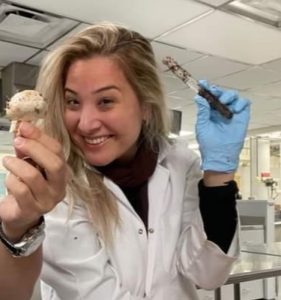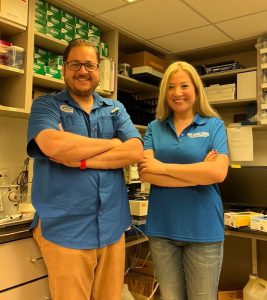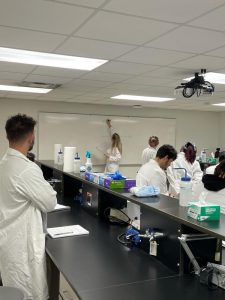 Welcome to our latest installment of FSHN Research Journeys, which follows the research of graduate students in the Food Science and Human Nutrition program at The University of Florida. Today’s guest poster is Gözde Gülseren, a first-year Ph.D. student in the food science graduate program. While working with Dr. Juan Andrade Laborde, Gözde is exploring the use of fungal-derived mycoproteins as a readily-absorbed, non-animal- and non-plant-based treatment for iron deficiency anemia. Read on to learn about her journey to UF, her critical research into iron supplementation, and her personal connection to her research project.
Welcome to our latest installment of FSHN Research Journeys, which follows the research of graduate students in the Food Science and Human Nutrition program at The University of Florida. Today’s guest poster is Gözde Gülseren, a first-year Ph.D. student in the food science graduate program. While working with Dr. Juan Andrade Laborde, Gözde is exploring the use of fungal-derived mycoproteins as a readily-absorbed, non-animal- and non-plant-based treatment for iron deficiency anemia. Read on to learn about her journey to UF, her critical research into iron supplementation, and her personal connection to her research project.
Gözde: For many years, I have suffered from micronutrient deficiencies. To overcome these deficiencies, I have used supplemental iron, B-vitamins, and vitamin D. Even with these supplements, I felt sick and tired, and I easily caught illnesses such as influenza. After taking these supplements for years, I started to feel a little better. Yet the effectiveness of supplements has a long way to go.

Micronutrient Deficiencies Can Lead to Macroscale Problems
Vitamins and minerals are micronutrients. Although we need these nutrients in small quantities, they are fundamental for physical and mental development. Essential micronutrients that are often limited in the diet include iron, zinc, calcium, iodine, vitamin A, vitamin E, B-vitamins, and vitamin D. The deficiencies of these micronutrients are also known as “hidden hunger.” Their deficiencies result in stunting and wasting, anemia, immune system deficiencies, or impaired cognitive development.1
Micronutrient malnutrition is a global health concern. According to the World Health Organization (WHO), more than two billion people suffer from micronutrient deficiencies worldwide. Even though anyone can experience micronutrient deficiency in a lifetime, pregnant women and children are at higher risk. This risk is especially high for those living in low-income countries.2 In these countries, low dietary intake and increased demand for micronutrients during pregnancy and childhood cause deficiencies. Based on global UNICEF data, at least half of children younger than five years of age suffer from vitamin and mineral deficiencies.3
The Trouble with Iron Supplementation

Iron is one of the essential minerals for human health and plays a significant role in many metabolic pathways such as in DNA and enzyme synthesis, oxygen transportation, erythropoiesis, metabolism, and immune function. Low iron status can cause iron deficiency anaemia (IDA) and it is attributed to poor physical, cognitive, and immune development and function.4
Many strategies exist to combat iron deficiency including supplementation, fortification (i.e., adding micronutrients to foods), and dietary diversification (i.e., consuming a variety of nutrient-dense foods). Iron supplementation is the most common method of combatting anemia Yet when iron supplements are used in excess, they can contribute to chronic diseases such as cancer, cardiovascular disease, or type-2 diabetes.5
On the other hand, iron fortification of foods increases population iron levels more slowly and safely. Yet fortification of foods is not as quick at targeting nutrient deficiency as supplementation. Still, food fortification has many benefits over supplementation. In addition to being a gentler way to combat micronutrient deficiencies, fortification can improve the health of a large number of people in a cost-effective manner without dependence on pharmaceutical supplements.4 Therefore, iron fortification of foods seems to be an effective and cost-effective strategy to reduce micronutrient deficiencies.

An Alternative Protein Source: Fungal-derived Mycoproteins
The body most easily absorbs iron from animal sources, such as meat, fish, and poultry; the iron in these foods is heme iron. In contrast, animal foods that are not derived from muscle tissue, such as milk and eggs, as well as plant-based iron sources often create compounds that decrease iron absorption.6 Therefore, proteins from animal muscles are most effective at improving iron status.
However, due to ethical and environmental concerns, some people look for meat substitutes. These consumers contributed to a rapid expansion of the meat substitute market that is predicted to have an annual turnover of $6 billion in 2022.7 Fungal-derived mycoproteins are gaining in popularity due to their nutritional profile and have been produced for use in commercially available alternative meat products for several decades.9
Advantages include being equal to muscle protein in nutritive value, having a protein content similar to eggs,10,11 and a similar digestibility to beef.12,13 In addition, these proteins can be produced at low cost, yield environmental benefits like using less land and water than animal-derived proteins, and are resilient to landscape limitations such as flood or drought, resulting in a sustainable product.
Why Mycelium Mycoproteins?

The part of mushrooms we can see is called the fruiting body, and the roots are called mycelium. A mycelium biomass consists of thread-like filaments that can grow into the soil, wood, and other substances, resulting in the uptake of nutrients and water.
Metals can bioaccumulate in the mycelial biomass, and solubilized iron bioaccumulation in the mycelial biomass is higher than in the fruiting body. Therefore, mycelial biomass can be used as an alternative non-animal food or iron-enriched functional food to overcome iron deficiency.16
However, research about food protein from fungi including the physical-chemical properties and functionality of mycelium mycoproteins related to iron absorption is still in its infancy. I hope to contribute to this crucial area of research with my project.
Since I faced a micronutrient deficiency problem for many years, I decided to study iron deficiency in my graduate research. Also, I want to research a sustainable protein source; therefore, I focused on finding supervisors who work in these two areas. Dr. Juan Andrade Laborde was one of them, and when I met him, he drew an effective framework for his future study plans that matched what I wanted to bring to my research project. Luckily, he invited me to join his research group. Since the University of Florida is one of the best universities in the food science area, I am so pleased to be here.

Mycoproteins Research Dynamics
In my lab, we study fungal-derived mycoproteins which also include mycelium mycoprotein. We want to discover their mechanisms to relieve iron deficiency as well as their protein functionality. I will focus on understanding the proteins’ microstructure, mechanical properties, barrier properties, and thermal stability. These properties play an important role in determining the functionality of the mycoproteins.
Next, I will evaluate iron absorption in cell or animal models. By examining cell wall structural changes during processing and digestion, I can evaluate potential mechanisms underpinning nutrient bioavailability from mycoprotein using different digestion models. Understanding structure-function mechanisms are essential for improving their use in food products and for broadening the use of underutilized protein ingredients by the food industry.
Gözde Gülseren is a Ph.D. student and teaching assistant in the Food Science and Human Nutrition Department at the University of Florida. She is originally from Istanbul, Turkey. A food engineer and professional tango dancer, Gozde is a big fan of jazz music, rocket engines, coffee, and eating French macarons.

References
- von Grebmer, K., Saltzman, A., Birol, E., Wiesmann, D. et al., 2014. Global Hunger Index The Challenge of Hidden Hunger.
- ‘Preventing and controlling micronutrient deficiencies in populations affected by an emergency: multiple vitamin and mineral supplements for pregnant and lactating women, and for children aged 6 to 59 months’, 2006. http://who.int/publications/m/item/
- ‘Child Nutrition’, 2019. http://data.unicef.org/topic/nutrition/child-nutrition/
- Shubham, K., Anukiruthika, T., Dutta, S., Kashyap, A. V., Moses, J., A. & Anandharamakrishnan, C., 2021. Iron deficiency anemia: A comprehensive review on iron abdorption, bioavability and emerging food fortification approaches. Trends in Food Science and Technology, 99, 58-75.
- Scheid, S. S., lecher Faria, M, G., Velasquez, L, G., do Vella., Goncalves. Jr, A. C. et al., 2020. Iron biofortification and avability in the mycelial biomass of edible and medicinal basidiomycetes cultivated in sugarcane molasses. Scientific Reports, 10:12875, natura.com/scientificreports
- Karava, N., N., Shinde, R., M. & Mahoney, R.. R., 2007. Formation of dialyzable iron in vitro digestion and extraction of mycoprotein. Food Chemistry, 15. 1630-1635.
- Ritchie, H & Roser, M., 2017. Micronutrient Deficiency. http://ourworldindata.org/micronutrient-deficiency.
-

Gözde in Vienna, Austria, her second home. Derbshire, E., J. & Delange, J. 2021. Fungal protein-what is it and what is the health evidence? A Systematic review focusing on mycoprotein. Nutritional Insight Ltd, London, United Kingdom.
- Tzachor, A., Richards, C., E. & Holt, L. (2021). Future foods for risk-resilient diets. Nature Food, 326-329
- Sadler, M.J., 2003. In: Encyclopedia of Food Sciences and Nutrition (Second Edition).
- Academic Press, Oxford, pp. 4072–4079. https://doi.org/10.1016/B0-12-227055-X/00820-8.
- USDA, 2021. FoodData Central [WWW Document]. URL https://fdc.nal.usda.gov/
- Edward, D.., Cumming, J.H., 2010. The protein quality of mycoprotein, in: Proceedings of the Nutrition Society. Cambridge University Press
- van Vliet, S., Burd, N.A., van Loon, L.J.C., 2015. The skeletal muscle anabolic response to plant-versus animal-based protein consumption. Nutr. 145, 1981–1991.
- Filho, P.,F., S., Andersson, D., Ferreira, J. A. & Taherzadeh, J. M., 2019. Mycoprotein: environmental impact and health aspects. World Journal of Microbiology and Biotechnology, 35:147. https://doi.org/10.1007/s11274-019-2723-9
- Umeo, S. Z., Faria., M., G., I., Dragunski, D., C., Do Valle, J., S. et al., 2020. Iron and zinc bioaccumulation in mycelial biomass of edible basidiomycetes. An Acad Bras Cienc, 92.
Looking for more posts exploring graduate research projects in the Food Science and Human Nutrition Department at the University of Florida?
Dive into the Research Journeys of other graduate students below.
M.S. Food Science
M.S. Nutritional Sciences
Ph.D. Food Science
Ph.D. Nutritional Sciences
 0
0

